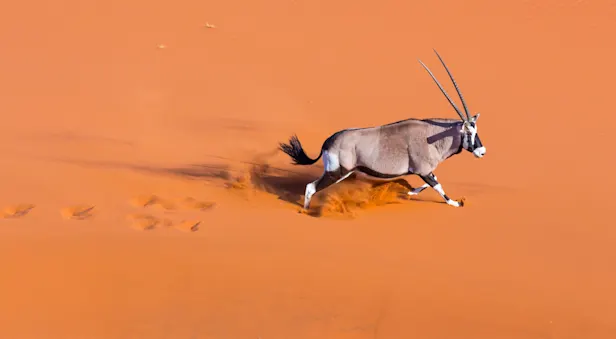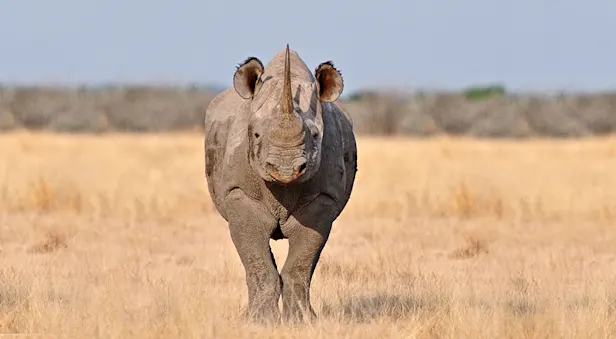Buffalo Facts | Southern Africa Wildlife Guide
The African buffalo is traditionally known as the meanest beast in the bush, prone to launch a killing charge at the drop of a hat. Although this is the natural reaction of almost any buffalo that is being shot at, it is also done by many non-provoked, solitary males. However, the majority of buffaloes in cow-calf herds are nearly as docile as cattle.
The most common species, a very large, black-pelted grassland dweller, can weigh up to 1,764 pounds. One subspecies, the forest buffalo, is smaller and reddish, with less robust horns. And at least two intermediate forms are found in grassland areas where large forests merge with grasslands. In East Africa, however, animals seen in forest clearings or along grassy roads will certainly be African buffalo.
Habitat
In general, buffaloes favor grassland, whether it be open, wooded or bushed. They feed and travel most often during the early morning, evening and nighttime. Buffaloes spend the rest of their time lying in shade, similar to cows in a field, although they likely sleep for only about an hour per day. They are never farther than nine miles from a water source, since they must drink every day.
Protection
The enormous, domineering horns of the buffalo, along with its pure size, offer it ample protection. These attributes have allowed blind, lame and even three-legged individuals to survive longer than could have been expected. Solitary bulls, however, without the formidable protection of numbers, commonly fall prey to prides of lions. It is not uncommon, though, for lions to be fatally injured during a prolonged battle with a wounded buffalo. When a buffalo herd is threatened by a lion attack, the bulls will form a protective semi-circle around the cows and calves, shielding them from harm.
An explosive snort from a buffalo heralds alarm. This is followed by a nose-up posture oriented at the intruder, who should begin looking for the nearest tree if the buffalo is a lone male. An alarm in a cow-calf herd will bring the others to attention, and those close to the intruder may even move forward, as if to have a better look. If the intruder stands its ground or even advances a few paces, the buffaloes will invariably turn tail with high head tosses, and the entire herd will run off.
Buffalo Society
Buffalo herds have relatively stable compositions, changed only by births and deaths. On average, group size for a Cape buffalo herd is about 350 members, but may contain as many as 20,000. However, this number is rarely larger than 20 for the forest subspecies. Large herds tend to fragment during the dry season and regroup in the wet, which aids in spreading the grazing load when grass is in short supply. During the dry season, there is a tendency to concentrate along the rivers. In the wet season, spacing over the habitat is quite regular. Each herd has a particular, fairly constant range, and there is little overlap between adjacent herds.
Despite their herding instincts, the basic social unit appears to be an adult female, her suckling calf from last season’s breeding and her two-year-old. When any one of the three is incapacitated, the other two will stick together. Vocalizations play only a small role in social encounters; calves bleat and cows grunt in order to call their calves. Otherwise, buffaloes remain relatively silent without the typical bovine lowing.
Cow-calf groups do not appear to have obvious leaders. Decisions on which direction a resting group should move next seem to be taken by a form of voting. During the period of resting and rumination, individual females occasionally stand up, face a particular direction for a few moments and then lie down again. After a couple of hours, the entire herd will move off in the direction that most buffaloes faced when standing. Voting seems to pay off for the herd, since it appears to take them in the direction of the greatest amount of grass in the area.
A Lot of Bull
Bachelor groups of 10 to 15 members are common, and may consist of either old, retired bulls that no longer compete for females, or younger bulls nearing their prime during the mating off-season, usually when it is dry. Solitary old males or small bull groups are the ones likely to charge intruders. Fighting males will circle each other for long periods, head tossing and pawing the ground.
The major threat is a lateral display, with the head lifted and nose pointed to the ground. Presented from the side, the thickness and power of the neck and shoulder muscles are shown to full advantage. Seen from the front, the posture emphasizes the size and raised surface edge of the horns. Two males squaring off will accentuate their horns with tossing, hooking movements and by thrashing nearby bushes. Such displays usually end with one animal giving up by simply walking away. Fights are therefore rare, which prevents potentially serious damage. When fights do occur, they consist of terrific head-on clashes.
Wallowing in mud holes is a common practice that appears to have a social function in addition to keeping animals cool and discouraging skin parasites. A particular wallow, apart from being foul smelling in its own right, may take on the scent of the bull which lays claim to it. The wallow thus serves as a passive territory marker. Cattle egrets can often be found in the company of wallowing buffaloes, and these birds give away the presence of buffalo concealed within a swamp.
Breeding
Males test for females in heat by sniffing their urine and genitals; fortunately, competition for their attention does not entail much fierce fighting. Posturing and mock battles serve as substitutes for conflict, which helps to keep these large, powerful animals from injuring one another. Courtship entails a temporary male-female bond, which ends shortly after mating.
The principal calving period occurs between December and February. Calves are carried for 11.5 months and are then dropped in the midst of the herd, usually during the rains. The afterbirth is eaten and the calf is licked clean, stimulated to defecate and suckle. Upon completion of this procedure, the calf joins the grazing herd.
Feeding Habits
Buffaloes are strictly grazers. Different species of grass and even their parts—leaves, stems and inflorescence—are selected on a basis of smell, taste and protein content. The amount of protein within vegetation is related to its tenderness, so grazers can weed out the nutritious from the coarse by the amount of effort needed to pull the plant apart.
Seasonal changes in grass availability and nutritional value dictate the local movements of buffalo in semi-arid areas. During the rainy season, they will feed on open plains; in the dry season, they retreat to woodlands, hill slopes and river fringes.Photo Credit: David Luck


























